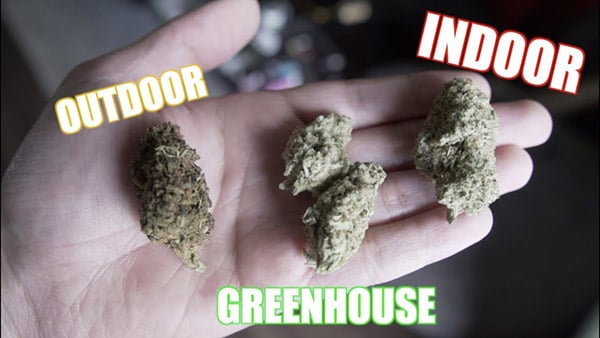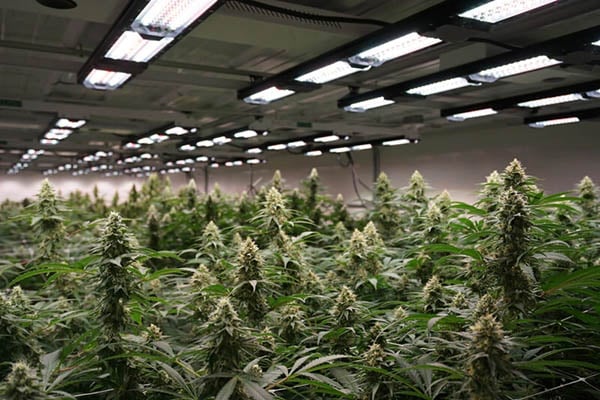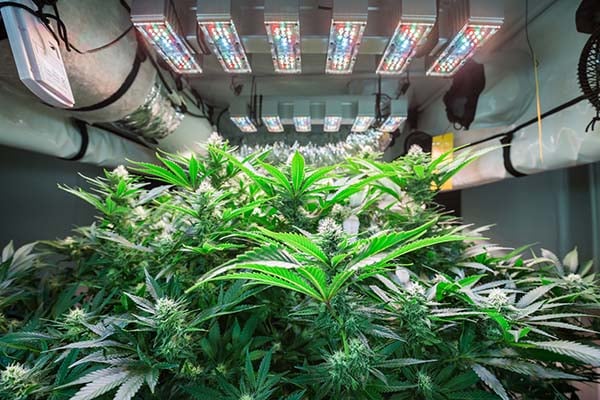What's the difference between indoor, outdoor, and greenhouse grown marijuana?
What's the difference between indoor, outdoor, and greenhouse-grown marijuana?

In some states, consumers are starting to see their options for marijuana expand. Not only with different strains or consumption methods but also from different growing environments.
Indoor, outdoor and greenhouse-grown marijuana is becoming distinct options, leaving many consumers wondering what the difference is and what works best for them.
But the truth is: there is no "best" option. Each environment has its strengths and weaknesses.
This article reviews the differences between indoor and outdoor-grown cannabis, the strengths and weaknesses, the impact on the final product, and the recommended strains for each environment.
Outdoor grown cannabis

When it comes to size, and the outdoor-grown pot is king. But while marijuana grown outside tends to produce larger buds, that doesn't always translate into higher THC levels. The yield of cannabinoids is usually comparable to that of weed grown indoors, with trichomes only distributed over a larger surface area. No grow light is comparable to the sun in cost or efficacy. Plants grown in full-spectrum sunlight tend to show fuller, more complete terpene distributions and richer cannabinoids than their indoor counterparts.
Unfortunately, they may not always look great. As outdoor-grown weed is exposed to the elements, it usually develops a darker color so that green buds may appear a muddy green and closer to a brown at the stem. Outdoor grown weed also grows thicker stems to withstand conditions such as wind, rain, and pests.
This is not unique to cannabis but simple botany. Even herbs like rosemary, chives, basil, etc., become hardier and tougher when grown outdoors.
Anyone who has ever moved a houseplant outdoors can attest that houseplants are relatively soft and not as hardy as their outdoor counterparts.
As a result, marijuana grown outdoors is a little rough around the edges, but it's also the cheapest to produce, with no lighting or ventilation costs. And those savings are often passed on to customers. That is if plants can survive the season. Not all areas are conducive to growing outdoors, but outdoor weed can thrive in milder climates with plenty of sunlight. Strains such as Sour Diesel and Critical Mass have been known to grow very well outdoors due to high yield potentials and heat resistance.
Indoor grown weed

Indoor farming began primarily as a clandestine solution to the illegal trade, but bringing marijuana into a controlled environment has led to a large number of hybrid varieties now available in most dispensaries.
Growing indoors amounts to a "manual operation," putting every choice or process determined by nature into the grower's hands. It's more work, but for those who have the resources and skills, this growing method allows them to fine-tune flavor, potency, and even yield to get a top consumer produce that remains consistently good and doesn't vary depending on the seasons or outdoor climatic changes.
The result is a beautiful product with high trichome density. Weed grown indoors under less harsh LEDs or high-intensity discharge bulbs will usually maintain a fresh green hue and not fade or darken over time. The denser buds also appear to be more covered with trichomes. Indoor buds are generally more efficient per ounce than outdoor buds because there is greater trichome density.
However, the cost of growing indoors is much higher. While outdoor-grown weed is nurtured by the sun and rain, marijuana grown indoors requires lights, fans, and water pumps that may run around the clock. Additionally, building costs and maintenance can be high.
This energy cost, usually expressed as the grams harvested per Watt of energy used to grow it (g/W). It is a business cost that must be passed on to the consumer to keep the said business running. In some states, such as Pennsylvania, where all medical cannabis has to be lab-grown, we can see a higher cost at the dispensaries than in other states without this restriction. Strains that produce tall, high-yield crops dense with buds tend to be preferable for indoor grow to increase the yield of cannabis per Watt used.
Greenhouse-grown weed

Indoor cannabis may benefit from controlled environments with managed lighting, but cannabis will always prefer sunlight. Therefore, greenhouse cultivation can capture the advantages of outdoor resources but protect against the harsher elements outdoor-grown weed is exposed to.
The biggest drawback is that growth is still limited by the sun's annual cycle, but some growers get around this hurdle through a strategy called light deprivation to maximize seasonal yields.
Unless you're growing auto-flowering strains, cannabis is a photoperiod plant, meaning its life cycle depends on the sun. In nature, as the days get shorter into autumn, plants perceive fewer hours of sunlight and know to bloom to reproduce.
Indoor growers simulate this sensation by manually changing the light cycles or switching from blue to red light wavelengths.
Of course, greenhouse growers can't change the sun, but they can block it with tarps or awnings. This light deprivation allows growers to fit in two or more growing cycles in a season while still taking advantage of the sun.
Using these free resources of nature can significantly reduce the environmental (and financial) costs of growing cannabis. The lights and fans run for hours a day for months at a time, and the final number of grams harvested per Watt soars. Marijuana grown in the sun is almost always cheaper to buy.
Conclusion
As more consumers come into contact with marijuana grown in different environments, debates about indoor versus outdoor cannabis or indoor versus greenhouse quality have spread.
Added to that, the increase in electricity costs and environmental impacts for growing weed and is becoming a hot topic of late.
There is no best or even better option, but all three have different strengths and weaknesses. Much of this will depend on climate as well.
Marijuana is grown outdoors often gains a larger size, but that doesn't necessarily translate into a higher THC percentage. However, cannabis grown in the sun will take on a more prominent terpene profile for a "fuller" flavor. It's also cheaper to produce and sell marijuana grown outdoors because light, ventilation, and even some nutrients are free in nature.
Indoor marijuana, by contrast, is often more expensive because of the higher cost of electricity needed to power lights, fans, and pumps, not to mention nutrients and fertilizer.
However, the advantage of this precise operation is that growers and breeders can fine-tune every step of the growth process, resulting in compelling new strains that are also more resistant to pests and mold than their ancestors.
Greenhouses combine the cheap resources of outdoor farming with the environmental controls of indoor agriculture. The greenhouse can be opened up for free ventilation and still benefit from cheap full-spectrum sunlight.
The only downside is that greenhouses are usually limited by the solar cycle, with only one harvest per season. Light deprivation, in which tarpaulins or shadows are pulled over plants, can be used to put more of the growing season into the greenhouse but often also results in reduced yields from each crop.
